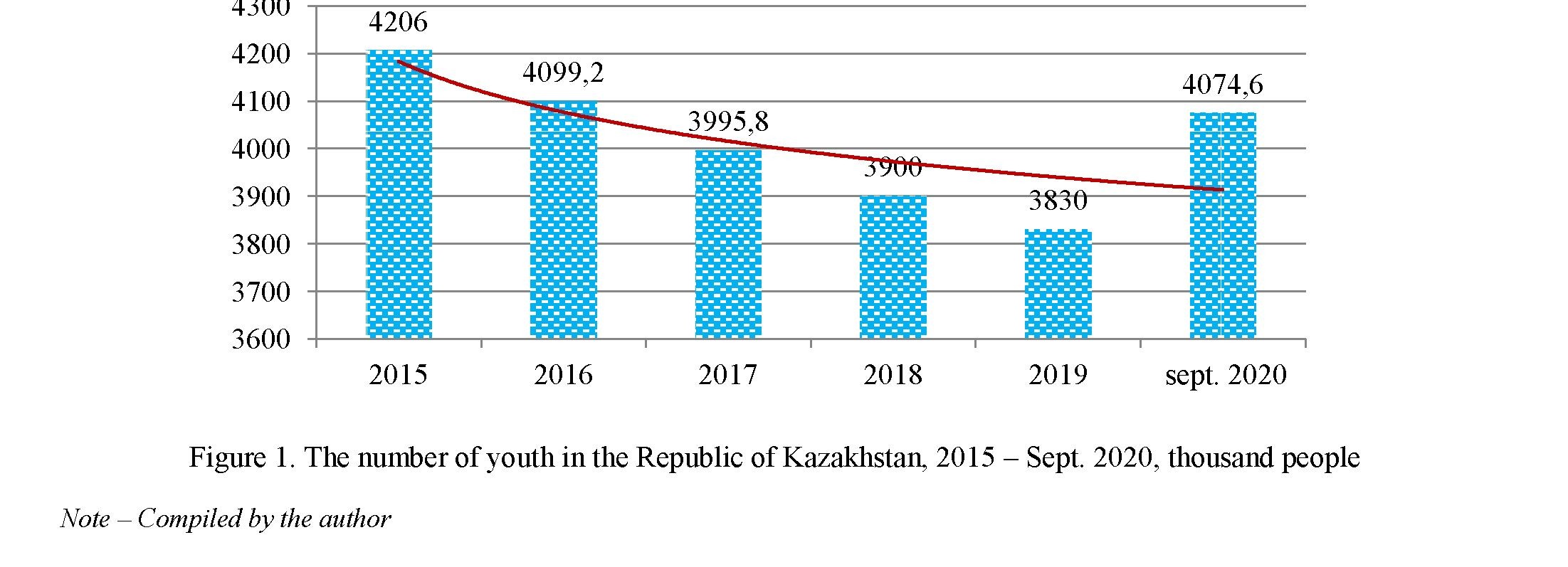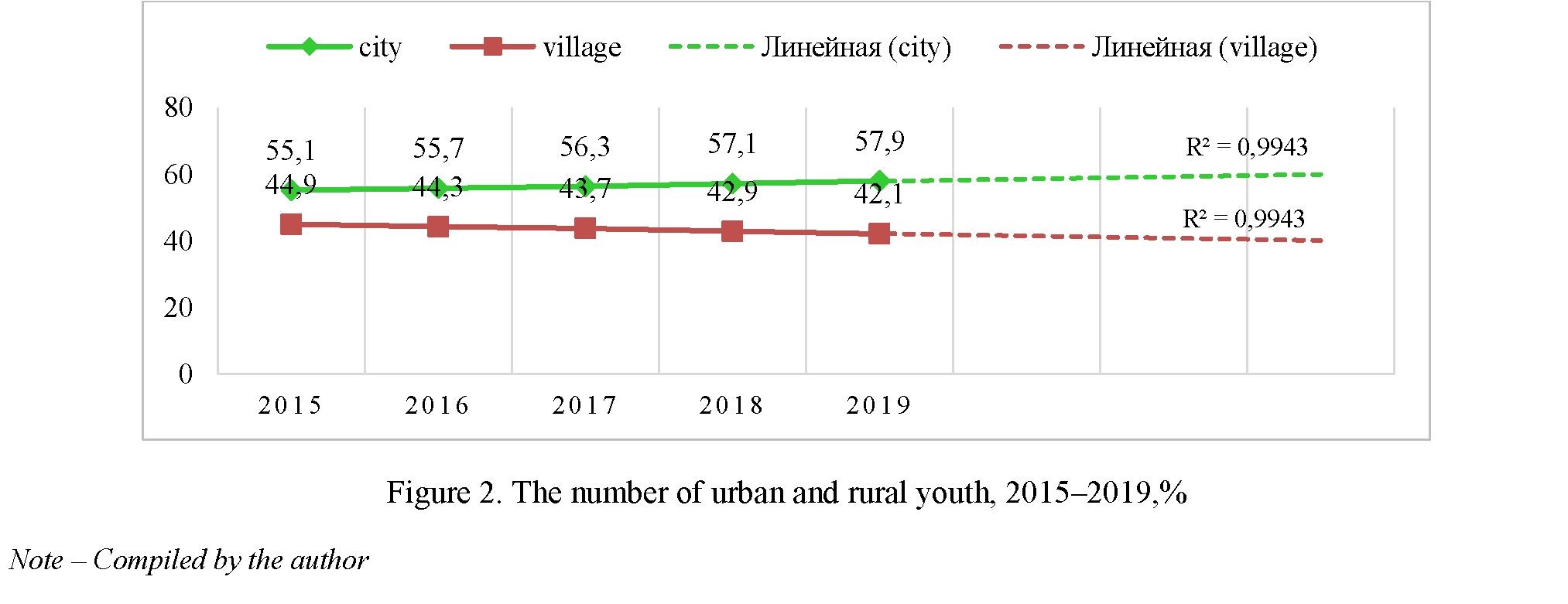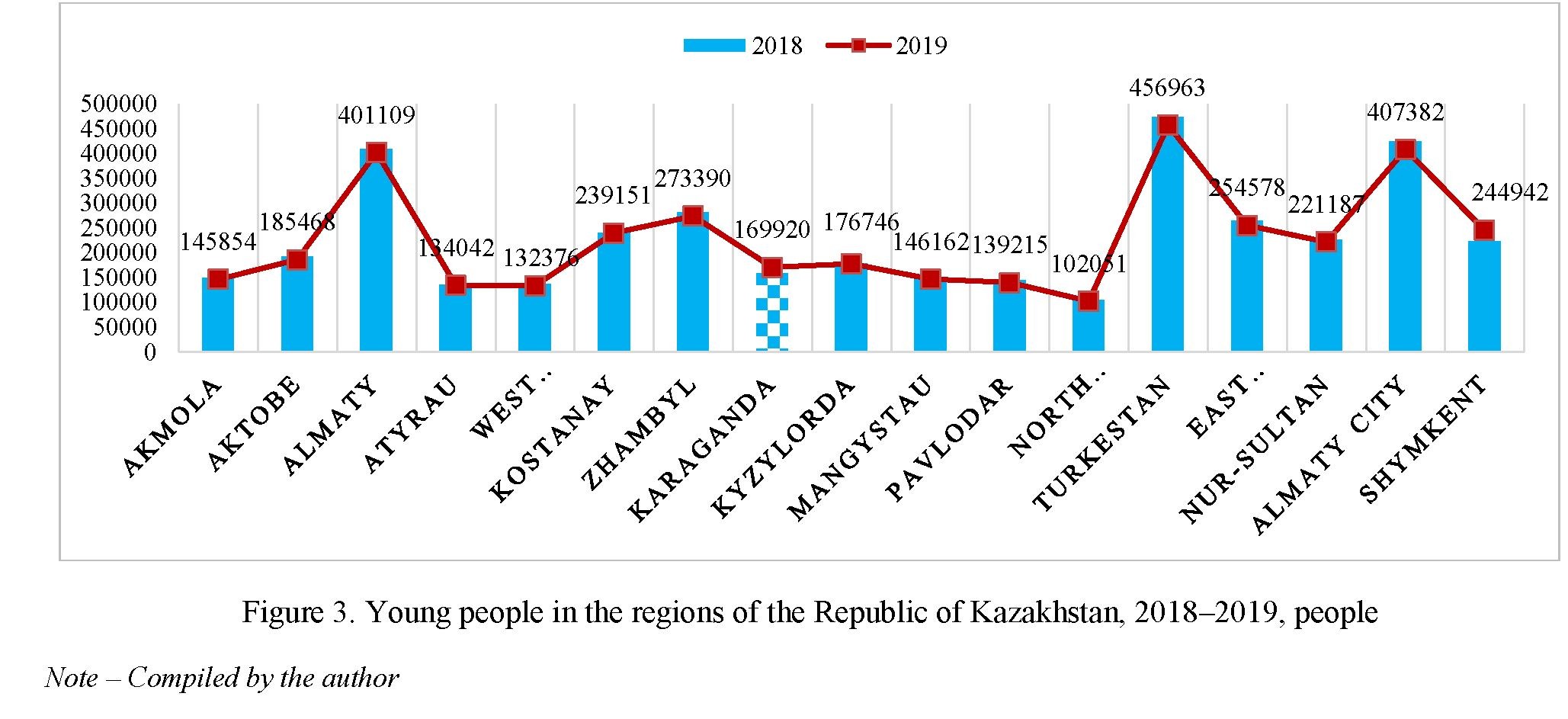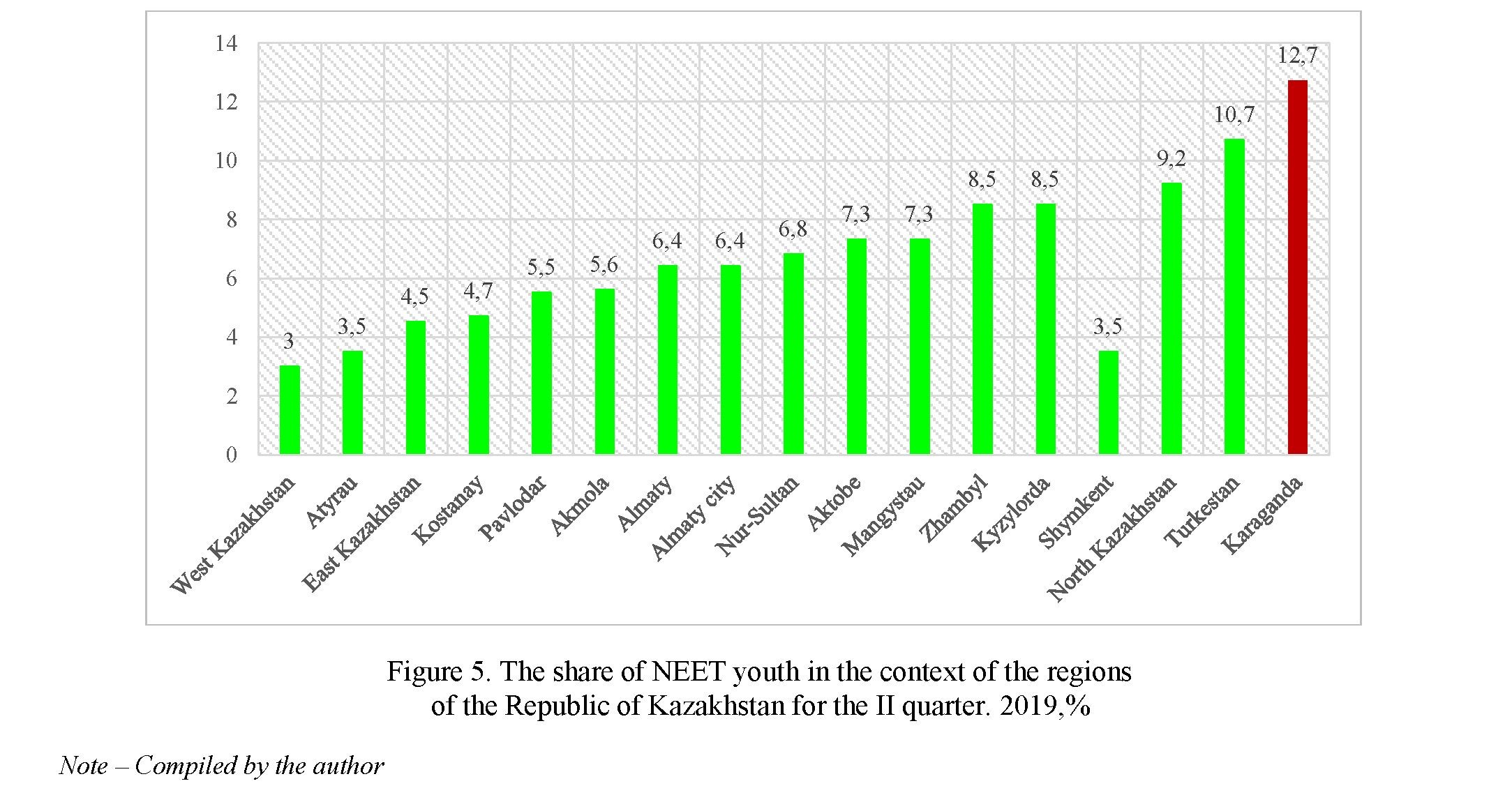Abstract
Object: The purpose of the study is to determine the dynamics and directions of the implementation of youth policy in the regional aspect, considering the dynamics and trends prevailing in this territory.
Methods: The article uses general scientific methods: analysis and synthesis, comparison and generalization, deduction and induction, scientific abstraction and concretization.
Findings: The article examines the dynamics and trends of regional youth policy in the Karaganda region. Among the negative trends in the implementation of youth policy, we note that the highest share of unemployed youth who are not engaged in either education or vocational training (12.1%) is in the Karaganda region (in comparison with other regions of the country).
Conclusions: We noted the immaturity and insufficient elaboration of the directions of regional youth policy, the absence of measurement criteria and regular monitoring aimed at identifying “bottlenecks” in working with youth; it is difficult to understand what problems the youth of the region feel. At the republican and regional levels, it is advisable to revise the methodological approaches to assessing the implementation of youth policy, to approve assessment indicators and a standard questionnaire of youth satisfaction.
Youth, as the “future of the nation” at all times, has been of particular value to society. It occupies an important place in social relations, the production of material and spiritual wealth. The position of young people in society and the degree of their participation in the development of the social environment depend both on their own active life position and on the state.
According to statistics, young people, that is, persons under the age of 30, make up half of the 19 million population of Kazakhstan, and represent a growing social group (Marlene, 2019). This is the generation born after Kazakhstan gained independence in 1991. Most of the young citizens, especially in the city, grew up in the conditions of the country’s relative prosperity and political stability. In addition, this category of citizens grows and is brought up in the context of the rapid digital transformation of the republic, the spread of the Internet and the widespread penetration of numerous social networks into their daily life (GARST, 2021).
The quality of the younger generation, as well as the degree of compliance with existing and necessary conditions and standards, depend on an effective youth policy. It includes the implementation of activities in all areas, from legal to moral and psychological (Rystina et al., 2014).
The topic of youth policy is one of the topical topics of the authorized bodies, which, in turn, allow identifying ways to improve this area.
The purpose of this study is to determine the dynamics and directions of the implementation of youth policy in the regional aspect, taking into account the dynamics and trends prevailing in this territory.
Features and problems of regional youth policy in Kazakhstani science still remain a “blank spot”. Certain issues of youth policy are reflected in the scientific publications of D.N. Aitzhanova (Aitzhanova, 2016), S.N. Bakytbekkyzy (Bakytbekkyzy, 2016), L.Yu. Zainieva (Zainieva, 2006), S.K. Islamgulova (Islamgulova, 2016), L.Yu. Zainieva (Zainieva, 2016), T.B. Kalieva (Kalieva, 2019), Zh.A. Kalieva (Kalieva, 2019), and other authors.
Authors Khusainova Zh.S., Zhartai Zh.M., Abauova G.M., Lambekova A.N., Syzdykova D.I. considered the issues of youth entrepreneurship, mechanisms of state support and foreign experience (Khusainova et al., 2020; Khusainova et al., 2019).
However, the topics of scientific publications mainly concern the republican aspects of the study of youth policy so far the authorized bodies are limited to annual national reports and publications in the media.
As for foreign authors, one can single out the study of the author G. Timmerman, in which he studies the issue of youth participation in political decision-making to instill in young people a greater commitment to democracy (Timmerman, 2009).
Of particular interest is the work of A. Plannas, P. Soler, M. Villa, in which they pay attention to the assessment of youth policy, to develop a system of assessment indicators in the field of youth policy of local authorities in Spain (Plannas, 2014).
Issues of youth policy in various European countries are considered by such authors as Xuan Li, J. Rogers, K. Mediratta, S. Shah, A. McCormack, K. Doran, M. Delgado and others (Li, 2020; Rogers et al., 2012; McCormack et al., 2014; Delgado et al., 2015; Augsberger et al., 2019).
In the works of American researchers, there is a growing recognition of the need to involve young people in the process of political decision-making as a mechanism for improving the situation of children (Smoter, 2021; Courtney et al., 2018; Forenza et al., 2018).
The literature review reveals different perspectives of research, practice and policy regarding the challenges and opportunities facing states to promote the positive development of youth (Lauxman, 2021). All this reflects an active scientific interest in the analysis and development of new mechanisms for youth policy.
The peculiarities of youth policy in the Republic of Kazakhstan are considered from the standpoint of methodological generalization and system analysis, in particular, through the generalization of classical and modern theoretical concepts. Using a systematic analysis of the study made it possible to determine the features of regional youth policy. In the course of the work, the following quantitative and qualitative methods were applied: Generalization, systematization, comparison, historical-logical, analysis, synthesis, deduction and the mathematical method of building trends. The research was based on analytical reports of the Bureau of National Statistics of the Agency for Strategic Planning and Reforms of the Republic of Kazakhstan, local executive bodies, as well as materials from periodicals and Internet resources.
Analyzing the data below, we can note the regions and cities where most of the people live: Almaty region (2 055 651 people), Turkestan (2 018 100) region, as well as Almaty (1 916 782), a smaller part – in North Kazakhstan region (548 751).
The largest population growth since 2015 was observed only in Almaty and the capital Nur-Sultan. In the Karaganda region, the population practically did not change and amounted to 1,376,827 people as of January 1, 2020 (7.4% of the total population of the country). The population of the Republic of Kazakhstan by the end of 2020 was 19,189,022 people. Natural increase was expected by 257,179 people (Figure 1).

As one can see in the diagram, the number of young people has been declining for several years in a row, but in 2020 there has been a positive trend. Therefore, the country’s political leadership today is focused on the quality development of youth as the nation’s most important resource.
In practice, there are problems in the field of youth policy in the regions associated with the following circumstances.
Firstly, neither the Concept nor the Action Plan contain either republic-wide or regional target indicators (indicators), by which one can get an idea of the effective implementation of state and regional youth policies.
Secondly, in the Action Plan there is a clear predominance of activities in one direction over others. For example, the direction “Involvement of young people in cultural, civic and spiritual and moral values” contains 33 events, while “Provision of affordable and high-quality education” – only 4.
Thirdly, not a single republican and regional online resource publishes reports on the results of sociological surveys of youth satisfaction conducted in the regions, no indicators have been established that allow assessing how effectively youth policy is being implemented at the regional level.
Judging by the trend calculations, an increase in the number of urban youth is expected in 2020–2022. (Figure 2).
A significant trend in recent years is the growth in the number of urban youth, since 2015 this indicator has grown by almost 3 percentage points. The regional distribution of youth is also heterogeneous; numerically, it predominates in the southern regions of the country (Figure 3).




Distribution of migration is an important component of modern youth policy. Thus, the analysis of indicators in the context of age (Figure 4) indicates two migration peaks: The first among 14-15-year-olds, the second at the age of 27-28.
An equally important indicator indicating the position of young people is the share of the NEET category, for the second quarter of 2019 it averaged 7.2% in the republic, and in the Karaganda region its share is 12.7%. This is the largest indicator among all regions of the country (Figure 5).
These trends are partly reflected in the Development Program of the Karaganda region for 2016–2020. However, to date, there is no regional youth development program and, accordingly, there are no reports on its implementation in the region.
As follows from the information posted on the official website of the State Institution “Department for Youth Policy of the Karaganda Region”, 878 million tenge was allocated from the regional budget for the development of youth projects in 2019, which is 50.6% higher than from 2018 (2018 – 582.7 million tenge).
Among the most significant events for young people in 2019 in the region are: International Forum of Rural Youth, V International Festival “RoboLand-2019”, Republican military-patriotic youth gathering “Aibyn” and others.
In 2020, 87 youth non-governmental organizations (NGOs) were registered on the territory of the Karaganda region, the most active are the Union of Youth and Children’s Organizations of the Karaganda Region, Zhas Otan (the youth wing of the Nur Otan party), Zhas Ulan, Zhas Horde, “Zhargyn bolashak”, “Youth Union of the Karaganda region”, “Temirtau youth club”, “For the sake of the future” and others.
In 2019, Youth Resource Centers held 3,256 events to provide psychological and legal assistance, support for youth initiatives, assistance in employment, etc.
Among the region’s achievements is the successful implementation of the project “With a diploma - to the village!”: In 2019, 482 young specialists in priority specialties arrived in rural areas (2017 – 151, 2018 – 386).
Currently, there are 89 volunteer groups in the region, covering about 5,000 young people from among students and students. There are also 63 military-patriotic clubs in the region, where more than 1,300 people are trained.
Summing up the results of the study, it can be seen that, in general, regional authorized bodies and NGOs have established stable interaction in various areas of youth policy with different age groups of young people.
There is immaturity and insufficient elaboration of the directions of regional youth policy in the Republic of Kazakhstan, the absence of regular monitoring aimed at identifying “bottlenecks” in work with youth, which does not allow highlighting the most acute problems that the youth of the region feel.
It should also be noted that the activities of authorized regional bodies are not transparent, indicators (indicators) of the effectiveness of youth policy have not been established.
At the republican and regional levels, it is advisable to revise the methodological approaches to assessing the implementation of youth policy, to approve assessment indicators and a standard questionnaire of youth satisfaction, to establish regular monitoring and reporting by authorized bodies. It is recommended to pay special attention to increasing the transparency of authorized bodies and creating a nationwide rating of youth policy in the context of the regions of Kazakhstan.
References
- Aitzhanova, D.N. (2016). Analiz yeffektivnosti gosudarstvennoi molodezhnoi politiki na osnove rezultatov sotsiologicheskogo issledovaniia sredi molodezhi Pavlodarskoi oblasti [Analysis of the effectiveness of state youth policy based on the results of sociological research among young people of Pavlodar region]. XIX International Conference "Culture, Personality, Society in the Modern World: Sbornik materialov konferentsii – Collection of conference materials. (pp.976–985). Ekaterinburg: UrFU [in Russian].
- Augsberger, A., Springwater, J.S., Hilliard-Koshinsky, G., Barber, K., & Martinez, L.S. (2019). Youth participation in policy advocacy: Examination of a multi-state former and current foster care youth coalition. Children and Youth Services Review, 107, 104491.
- Bakytbekkyzy, S.N. (2016). K voprosu o patrioticheskom vospitanii kazakhstantsev [On the issue of Patriotic education of Kazakhstan]. Problemy sovremennoj nauki i obrazovaniya – Problems of modern science and education, 3(45), 218–221 [in Russian].
- Courtney, M. E., Okpych, N. J., Park, K., Harty, J., Feng, H., Torres-Garcia, A., & Sayed, S. (2018). Findings from the California youth Transitions to Adulthood Study (CalYOUTH): Conditions of youth at age 21. Chicago, IL: Chapin Hall at the University of Chicago.
- Delgado, M. (2015). Community practice and urban youth: Social justice service-learning and civic engagement. Routledge.
- Forenza, B. (2018). Awareness, analysis, engagement: Critical consciousness through foster youth advisory board participation. Child and Adolescent Social Work Journal, 35(2), 119–126.
- Garst, B.A., Pann, J., Berry, T., Biesecker, G., Spector, J., Conn, M., & Jones, C. (2021). Building Evaluation Capacity in Youth-Serving Organizations Through Evaluation Advisory Boards. Journal of Youth Development, 16(4), 52– 69.
- Islamgulova, S K. (2016). O molodezhnoi politike v Kazakhstane i formirovanii tsennostnykh prioritetov [On youth policy in Kazakhstan and formation of value priorities]. Izvestiia Volgogradskogo gosudarstvennogo pedagogicheskogo universiteta – Proceedings of the Volgograd State Pedagogical University, 3(98), 56–64 [in Russian].
- Kaliev, T.B. (2019). Opyt Kazakhstana v realizatsii molodezhnoi politiki [Kazakhstan’s Experience in implementing youth policy]. Materials of the all-Russian scientific and practical conference. (pp. 136-139). T.K. Rostovskii (Ed.). Moscow [in Russian].
- Kalieva, Zh.A. (2019). Sotsiologicheskaia refleksiia molodezhnykh obedinenii: teoriia i praktika (na primere respubliki Kazakhstan) [Sociological reflection of youth associations: theory and practice (on the example of the Republic of Kazakhstan). Extended abstract of candidate’s thesis. Saratov [in Russian].
- Khussainova, Zh.S., Abauova, G.M., Bektleyeva, D.Ye., & Zhartay, Zh.M. (2019) Institutional mechanisms to support of the youth entrepreneurship: domestic and foreign experience. Bulletin of Karaganda University. Economy Series. 94 (2), 101-112.
- Laruelle, M. (2019). Introduction: The Nazarbayev generation: A sociological portrait. The Nazarbayev Generation. Youth in Kazakhstan. Edited by Marlene Laruelle. New York: Lexington Books, 1–21.
- Lauxman, L.A., Archibald, T., Dowling, E. M., & Jessee, C. (2021). International positive youth development: Challenges and opportunities in policy and practice. Journal of Youth Development, 16(2-3), 1–12.
- Li, X. (2020). The critical assessment of the youth policy and youth civic engagement in Denmark and three Danish municipalities. Children and Youth Services Review, 110, 104743.
- Planas, A., Soler, P., & Vilà, M. (2014). Assessing youth policies. A system of indicators for local government. Evaluation and program planning, 45, 22-28.
- Rogers, John, Kavitha Mediratta, & Seema Shah. (2012). Building Power, Learning Democracy: Youth McCormack, Aideen, & Doran, Cormac (2014). Apathetic or Engaged? Exploring Two Paradigms of Youth Civic Engagement in the 21st Century. The ITB Journal, 15 (2) 4. doi:10.21427/D7443Z. Retrieved from:
- https://arrow.tudublin.ie/itbj/vol15/iss2/4
- Rystina, I., & Kussainova, Z. (2014). Comparative Analysis of National Youth Policy in Different Countries. Procedia - Social and Behavioral Sciences, 140, 654–656. doi:10.1016/j.sbspro.2014.04.487
- Smoter, M. (2021). Outreach Practices of Public Employment Services Targeted at NEET Youth in Poland. Youth & Society, 0044118X211058224.
- Timmerman, G. (2009). Youth policy and participation. Children and Youth Services Review, 31(5), 572–
- 576. doi:10.1016/j.childyouth.2008.10.
- Zainieva, L.Yu. (2006). Gosudarstvennaia molodezhnaia politika: Kazakhstan v kontekste mirovogo opyta [State youth policy: Kazakhstan in the context of world experience]. Almaty: Daik-Press – Dyke-Press, 185–189 [in Russian].
- Zainieva, L.Yu. (2013). Stanovlenie gosudarstvennoi molodezhnoi politiki v Kazakhstane [Formation of the state youth policy in Kazakhstan]. Yaroslavskii pedagogicheskii vestnik – Yaroslavl Pedagogical Bulletin, 2, 133–137 [in Russian].
- Khussainova, Zh.S., Abauova, G.M., Bektleyeva, D.Ye., & Zhartay, Zh.M. (2019) Institutional mechanisms to support of the youth entrepreneurship: domestic and foreign experience. Bulletin of Karaganda University. Economy Series. 94 (2), 101-112.